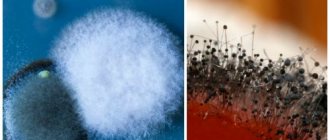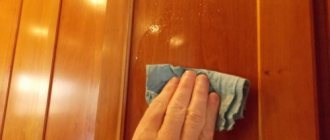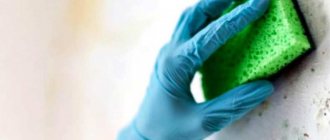Despite the huge variety of modern materials in the construction markets, wood still remains the most in demand. But unfortunately, it has a main drawback - with high humidity, it begins to become moldy and may even begin to rot. But in order to avoid these negative consequences, you need to take care of this by treating the wood with special solutions.
Mold on wood
Causes of wood rotting:
- more than 80% increase in indoor humidity;
- high humidity of the tree itself;
- no air circulation;
- condensation forms;
- from severe frost and insufficient protection of the wood, it freezes;
- comes into contact with the surface of the earth;
- condensation forms.
Mold damage to a wooden surface
Methods for preventing mold and mildew:
- You cannot use freshly cut wood - it must dry for about a year;
- it is necessary to waterproof the apartment and other rooms so that there is no “dew point”;
- carry out protective work against atmospheric humidity with specialized impregnations and paints and varnishes;
- To prevent condensation from forming, it is necessary to make a vapor barrier on the inner surface of the walls, and thermal insulation on the outside.
Removing mold from wood
Sulfur checker
If you don’t know how to get rid of mold in the basement of a wooden house, use a sulfur bomb. This is a fine aerosol that, when combined with air, forms a deadly mixture for fungus and its spores. At the same time, the smallest particles easily penetrate the narrowest crevices of wooden surfaces, being an effective way in the fight against mold.
Folk recipes for protecting wood from mold and mildew
There are the following methods of treatment with folk remedies:
- The method is to treat the surface with silicate glue. To do this, you need to take it and dilute it with water until a fluid solution is formed, the main thing is that it is not too liquid. The resulting solution should be used to saturate the wooden structure of the walls of a cellar, basement, etc.
- method - this will be a method using more complex components - such as 5% solutions of potassium dichromate and sulfuric acid. These components must be combined in a 1:1 ratio and impregnated with wood.
- The method is much simpler compared to previous methods, since it requires components that are quite common in everyday life - soda and vinegar. Apply baking soda to the moldy area, and sprinkle vinegar on top, possibly using a spray bottle.
- method - this method is used by treating the walls with copper sulfate (about 100 g). It can be purchased in stores dedicated to gardening; in addition, it is often found in construction markets. To begin with, it should be diluted in 10 liters of ordinary water. To increase the effect, add 1 tbsp to the mixture with Copper sulfate. l. vinegar. Now you need to mix everything thoroughly. And then treat the required surfaces with copper sulfate. This substance is considered toxic.
Copper sulfate helps prevent mold from growing on woodAfter treating surfaces with copper sulfate, for safety reasons, you should leave the room until it dries completely (2-3 days). This method is perfect for treating cellar walls.
- method - you need to make the following solution: mix 5 liters of boiling water with 50 g of Boric acid and add 1 kg of table salt. The surface should be soaked with this solution a number of times at intervals (approximately 2 hours).
The methods considered will be effective if mold and mildew occupy a small part of the surface. If the affected area is large enough, then more serious methods should be used.
Sequencing
To combat pathogenic flora that destroys wood, it is important not only the product, but also the preparation of the surface.
To achieve maximum effect, you need:
- Choose suitable conditions - the outside temperature should not be lower than 5℃. Sunny, warm and dry weather is considered optimal.
- Prepare the surface - use a metal brush to remove any lesions and allow to dry thoroughly.
- Apply the product - if the damage is deep, it makes sense to apply the treatment 3-4 times, leaving time intervals for complete drying.
- Treat with a protective coating - to protect the wood from further destruction, after disinfection it is necessary to open it with paint and varnish compounds that prevent the absorption of moisture and the development of rot.
Have you ever had to deal with mold on wood?
It happened, it didn't happen
It is recommended to destroy peeled wood shavings with obvious signs of mold. The best way is to burn it in a fire. If you throw it in the trash or bury it in the ground, the fungus will continue to exist, and its spores can reappear on wooden surfaces.
Preservation and application of antiseptic
Experts believe that the most effective methods are preservation and coating with an antiseptic.
Canning is the coating of materials with special substances. Such impregnations as:
- diffusion;
- autoclave
As a rule, preservation is carried out in a high-pressure vacuum. This is a special advantage in which this composition penetrates quite deeply.
Treat with an antiseptic - means superficial penetration, which prevents the appearance and proliferation of unwanted substances.
Antiseptic treatment against mold
Methods used when applying antiseptics:
- using a brush;
- using atomizers or sprayers;
- by immersing materials in a specialized antiseptic solution. The solution can be either hot or cold.
Protective compounds used in surface treatment:
- antiseptics;
- various types of paints;
- varnishes
By painting, wood can be protected from moisture, while creating the most aesthetically pleasing appearance for this material. As a rule, for processing material inside a building (in an apartment, for example, or in cellar buildings), you need to use water-soluble paints, and for exterior work - only those made with an organic solvent.
By varnishing wood, you can not only end up with a beautiful matte and glossy finish, but also get a special film that will protect the wooden surface from moisture and fungi, prevent the product from fading and, thanks to it, prevent destruction.
Antiseptics are used most often when the wood is already susceptible to mold.
Types of antiseptics:
- water-soluble products. These products do not adversely affect humans and various animals. They dry quite quickly. You can buy them in two types: there are powder and aqueous solutions. Such solutions are actively used when treating walls, etc. in an apartment and other rooms. But you cannot use this type of antiseptic where the wood comes into direct contact with water.
- another type is water-repellent. They are characterized by significant, compared to the first type, penetration into the wooden structure. These types have a strong odor. They are actively used for baths, saunas, as well as basements and cellars - where the humidity is high.
- antiseptics that are made on the basis of solvents. They are used to treat surfaces both externally and internally on walls, floors, etc. Treatment with this antiseptic dries for up to 12 hours.
- oil products. The main feature of these products is that they must be used on dry surfaces, otherwise the fungus will corrode the wood from the inside.
Use of oil-based wood treatmentsIn this case, a special film is formed on the surface, which protects the desired surface for a long time. Such protective equipment cannot be used in an apartment or other residential premises.
- combined means of protection. They are designed for use in various rooms under any conditions, even for the walls of the cellar and basement. Their main feature is good fire safety.
As they are absorbed, antiseptics are divided:
- for glazing - they are colorless and do not change the color of the surface being coated;
- covering compounds. They penetrate quite deeply, changing the color of the wood.
Antiseptics should also be distinguished by purpose:
- for interior work indoors;
- for outdoor.
For example, paint and varnish antiseptics can be used for exterior work, because they are not negatively affected by external factors. Products intended for work inside are, as a rule, resistant to mechanical influences, but not resistant to ultraviolet radiation and significant temperature changes.
When choosing a means of protecting wood from fungal deposits and mold, you should know the characteristics of each type, and already purchase a product that is suitable for your surface.
Antiseptic treatment of all wooden surfaces
Prevention methods
The set of preventive measures will take less time than treating a simple fungus at home. Problems are easier to prevent, so it is important to ensure their ventilation in a bathhouse or wooden house.
Hydro- and vapor barrier
The main reason for the formation of pathogenic microorganisms is excessive humidity levels and the influence of steam. It is important to protect furniture and structures from this. Therefore, it is imperative to use special varnishes that protect the wood.
In a room where the humidity is always exceeded due to objective factors, for example, in a bathhouse, it is necessary to ensure a pleasant microclimate and regular ventilation.
Roof and foundation integrity
Before putting the house into operation, the roof and foundation must be covered with paints, varnishes and antiseptics. The appearance of fungus in these structures is not always noticeable, but as a result they grow and cause harm. Cleaning and application occur only on a clean surface; brushes, sprayers and rollers are used.
Vapor barrier membrane for protection against condensation
A vapor barrier membrane will protect against condensation and serve as an additional measure. The event is presented as a whole.
Features when processing wood surfaces
Thanks to the film that forms on the wood, the coating is reliably protected from moisture and pests. But the problem is that it is difficult to evenly distribute the protective agent over the entire surface due to the unevenness that exists on the wood.
Due to the variety of types of wood, they are impregnated differently.
For example, it is difficult to use antiseptics on coniferous trees; also species such as ash, beech, and birch have a high level of resistance to these agents.
A lot depends on the moisture content of the wood, so you should first dry the material and only then treat it with an antiseptic.
Reasons for appearance
Depending on the type of fungus, gray, black, bluish-green and white stains may appear on untreated wooden surfaces. In conditions of high humidity and constant wetting of the board, mold grows, filling the entire space, affecting other places and objects.
Causes of fungus:
- presence of spores on wood;
- room temperature is not higher than +21 ° C and air humidity is 80-95%;
- lack or insufficient ventilation in the house;
- uneven heating of the room;
- lack of insulation and waterproofing under the floor;
- condensation formation due to temperature fluctuations;
- infection of wood with fungal spores by bark beetle;
- presence of sources of constant exposure to moisture;
- lack of sunlight in basements;
- the use of logs with damaged cores and nests of rot;
- freezing of wet boards.
As mold grows, it eats into the fibrous, porous layers of wood, and toadstools or plaque with spores appear. If there are no favorable conditions, then the fungal spores do not germinate.
Preventing food contamination
Who wants to suffer from food poisoning? Follow these simple tips to avoid such problems:
Buy hard acrylic or rubber boards as they are the most hygienic to use (these are the boards commonly used in restaurants). Wooden boards should be disinfected regularly and kept as clean as possible. It is convenient to have several boards for different types of food. You should have at least two of them: one for raw meat and fish, the other for vegetables, bread and any other foods that can be eaten raw. Buy colored sets of cutting boards or label the boards yourself, this will make it much easier to distinguish them by purpose. Throw away any cutting boards that have cracks, large scratches, or obvious signs of dirt.
Like all kitchen utensils, cutting boards have an expiration date and it is important to dispose of them promptly to maintain kitchen hygiene and cleanliness.
Processing cutting boards
Most wooden cutting boards are made from hardwoods such as teak, although bamboo cutting boards are also quite common. Any type of wood should be treated to prevent stains and keep food odors and bacteria from lingering on the surface.
Use an oil that can be used repeatedly, such as food-grade mineral oil.
It is safe and will fill the pores of the wood well. Another name is liquid paraffin, edible petroleum jelly. Rub the oil onto the board and let it soak into the wood. Wipe off excess oil with a clean, dry cloth. Repeat this process at least once a month.
Attention! Do not use vegetable oil on cutting boards. This oil will go rancid and cause an unpleasant odor.
After mineral oil, apply beeswax
, it will make the surface of the board waterproof, which will protect the wood from wear and tear and extend its service life. In a microwave-safe container, microwave 1/2 teaspoon (2.5 ml) beeswax with 1 cup (240 ml) mineral oil for about 45 seconds. Apply warm wax to cutting board. Based on materials from www.cleanipedia.com, ru.wikihow.com
Wooden kitchen cutting boards have many advantages compared to their plastic and ceramic counterparts. Products do not slip on their surface, allowing you to cut them much more confidently and quickly. In addition, dense wood, in addition to its environmental friendliness, is also famous for its durability, so wooden boards last much longer than their other analogues.
But wooden cutting boards have their drawbacks. The main ones are the ability of wood to absorb odors and change its appearance for the worse. In order for the board to last longer, it is necessary to properly care for it. I hope now you know how to do it :o)….
Over time, kitchen boards absorb odors, and this problem can no longer be solved by simply washing. It’s not very pleasant to cook on such a household item, but you shouldn’t throw it away right away, since cutting boards in the kitchen can be cleaned effectively and in a short time.











